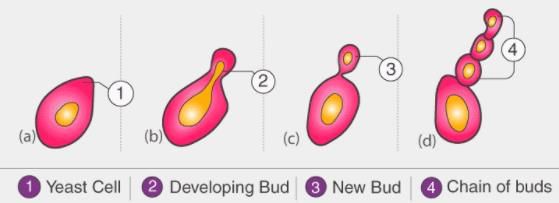Class 7 Exam > Class 7 Questions > The small bulb-like projection coming out fro...
Start Learning for Free
The small bulb-like projection coming out from yeast cell is called a ______.
- a)Pseudopodia
- b)Bud
- c)Fragment
- d)False - feet
Correct answer is option 'B'. Can you explain this answer?
Verified Answer
The small bulb-like projection coming out from yeast cell is called a ...
- Budding is a type of asexual reproduction in which a new organism develops from an outgrowth or bud due to cell division at one particular site. The small bulb-like projection coming out from the yeast cell is called a bud.
- Organisms such as hydra use regenerative cells for reproduction in the process of budding.

Most Upvoted Answer
The small bulb-like projection coming out from yeast cell is called a ...
When the yeast is matured from it a small structure comes from its lower part which is called bud
Free Test
FREE
| Start Free Test |
Community Answer
The small bulb-like projection coming out from yeast cell is called a ...
- Budding is a type of asexual reproduction in which a new organism develops from an outgrowth or bud due to cell division at one particular site. The small bulb-like projection coming out from the yeast cell is called a bud.
- Organisms such as hydra use regenerative cells for reproduction in the process of budding.


|
Explore Courses for Class 7 exam
|

|
Question Description
The small bulb-like projection coming out from yeast cell is called a ______.a)Pseudopodiab)Budc)Fragmentd)False - feetCorrect answer is option 'B'. Can you explain this answer? for Class 7 2025 is part of Class 7 preparation. The Question and answers have been prepared according to the Class 7 exam syllabus. Information about The small bulb-like projection coming out from yeast cell is called a ______.a)Pseudopodiab)Budc)Fragmentd)False - feetCorrect answer is option 'B'. Can you explain this answer? covers all topics & solutions for Class 7 2025 Exam. Find important definitions, questions, meanings, examples, exercises and tests below for The small bulb-like projection coming out from yeast cell is called a ______.a)Pseudopodiab)Budc)Fragmentd)False - feetCorrect answer is option 'B'. Can you explain this answer?.
The small bulb-like projection coming out from yeast cell is called a ______.a)Pseudopodiab)Budc)Fragmentd)False - feetCorrect answer is option 'B'. Can you explain this answer? for Class 7 2025 is part of Class 7 preparation. The Question and answers have been prepared according to the Class 7 exam syllabus. Information about The small bulb-like projection coming out from yeast cell is called a ______.a)Pseudopodiab)Budc)Fragmentd)False - feetCorrect answer is option 'B'. Can you explain this answer? covers all topics & solutions for Class 7 2025 Exam. Find important definitions, questions, meanings, examples, exercises and tests below for The small bulb-like projection coming out from yeast cell is called a ______.a)Pseudopodiab)Budc)Fragmentd)False - feetCorrect answer is option 'B'. Can you explain this answer?.
Solutions for The small bulb-like projection coming out from yeast cell is called a ______.a)Pseudopodiab)Budc)Fragmentd)False - feetCorrect answer is option 'B'. Can you explain this answer? in English & in Hindi are available as part of our courses for Class 7.
Download more important topics, notes, lectures and mock test series for Class 7 Exam by signing up for free.
Here you can find the meaning of The small bulb-like projection coming out from yeast cell is called a ______.a)Pseudopodiab)Budc)Fragmentd)False - feetCorrect answer is option 'B'. Can you explain this answer? defined & explained in the simplest way possible. Besides giving the explanation of
The small bulb-like projection coming out from yeast cell is called a ______.a)Pseudopodiab)Budc)Fragmentd)False - feetCorrect answer is option 'B'. Can you explain this answer?, a detailed solution for The small bulb-like projection coming out from yeast cell is called a ______.a)Pseudopodiab)Budc)Fragmentd)False - feetCorrect answer is option 'B'. Can you explain this answer? has been provided alongside types of The small bulb-like projection coming out from yeast cell is called a ______.a)Pseudopodiab)Budc)Fragmentd)False - feetCorrect answer is option 'B'. Can you explain this answer? theory, EduRev gives you an
ample number of questions to practice The small bulb-like projection coming out from yeast cell is called a ______.a)Pseudopodiab)Budc)Fragmentd)False - feetCorrect answer is option 'B'. Can you explain this answer? tests, examples and also practice Class 7 tests.

|
Explore Courses for Class 7 exam
|

|
Signup for Free!
Signup to see your scores go up within 7 days! Learn & Practice with 1000+ FREE Notes, Videos & Tests.



















